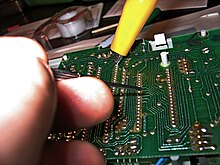Circuit bending usually involves dismantling the machine and adding components such as switches and potentiometers that alter the circuit. The circuit-bent instrument, often a re-wired audio toy or game, is an alien instrument: alien in electronic design, alien in voice, alien in musician interface. Through this procedure, all around our planet, a new musical vocabulary is being discovered.
A new instrumentarium is being born. Countless audio gadgets are experimental musical instruments waiting to happen. Circuit-bending's anti-theory approach to electronic design makes accessible to all audio explorers an endless frontier of original sound-forms to discover, and fantastic instruments to create. Within these adapted devices, along with the unusual voices of circuit-bending, are often found aleatoric music generators; that is, chance-music composers that stream unpredictable audio events: elements shifting and re-combining in fascinating ways.
The circuit bending process has been developed largely by individuals with next to no formalised training in electronic theory and circuit design, experimenting with second-hand electronics in a DIY fashion, either with inexpensive keyboards or drum machines, or with electronic toys not associated with musical production. Haphazard shorting out of electronic items will almost inevitably at some time lead to the destruction of the circuit being prodded about. Worse still, it could present risk of fire, burning or electrocution
Aesthetic value, immediate usability and highly randomized results are often factors in the process of successfully bending electronics. Although the history of electronic music is often associated with unconventional sonic results, such innovators as Robert Moog and Léon Theremin were electrical engineers, and more concerned with the consistency and sound design of their instruments.
Circuit bending is typified by inconsistencies in the instruments built in an unscientific manner. While many pre-fitted circuit bent machines are on offer for sale at auction sites such as eBay, this somewhat contravenes the intention of most practitioners. Machines bent to a repeated configuration are more analogous to the well known practice of "mods", such as the Devilfish mod for the Roland TB-303, the famous Speak and Spell toys or various Analogman or Pedaldoc guitar pedal circuit modifications.
Circuit bending an audio device typically involves removing the rear panel of the device and connecting any two circuit locations with a "jumper" wire, sending current from one part of the circuit into another. Results are monitored through either the device's internal speaker or by connecting an amplifier to the speaker output. If an interesting effect is achieved, this connection would be marked for future reference or kept active by either soldering a new connection or bridging it with crocodile clips. Often other components are inserted at these points such as pushbuttons or switches, to turn the effect on or off; or components such as resistors or capacitors, to change the quality of the audio output.
This is repeated in a trial and error basis. Other components added into the circuit can give the performer more expressiveness, such as potentiometers, photoresistors (for reaction to light) and pressure sensors. The simplest input, and the one most identified with circuit bending, is the body contact, where the performer's touch causes the circuit to change the sound. Often metal knobs, plates, screws or studs are wired to these circuit points to give an easier access to these points from the outside the case of the device.
Perfect targets for circuit-bending are audio games and toys that already produce interesting, good-sounding voices. Synthesized human and animal voices, as well as imaginary and musical sounds reside within many of these gadgets. As mentioned, musical keyboards, even sampling keyboards, turn up at these second-hand stores now and then.Keyboards often produce chance (aleatoric) music when circuit-bent. Reedcalls these circuit-bent instruments Aleatrons. (Casio SK-1 article here, Aleatron ). These games/toys/keyboards can often be bought for a few dollars each.

Although similar methods were previously used by other musicians and engineers, this method of music creation is believed to have been pioneered by Reed Ghazala in the 1960s. Ghazala's experience with circuit-bending began in 1966 when a toy transistor amplifier, by chance, shorted-out against a metal object in his desk drawer, resulting in a stream of unusual sounds.
Citrate bending incorporates a lot of random factors with in its image of cute toy hacking. A random factor which doesn't seem to hold any order in a musical style. It is possible to sample, record and edit these glitches which adds something to the musical mix, but personally such sounds seem untamed and uncontrollable with a live sound show. I mentioned before that Controllerism is a branch of electronic music, which can be the ultimate in new music expression. Then its kissing cousin is Circuit bending , whose very nature is more artistic then musical.



No comments:
Post a Comment